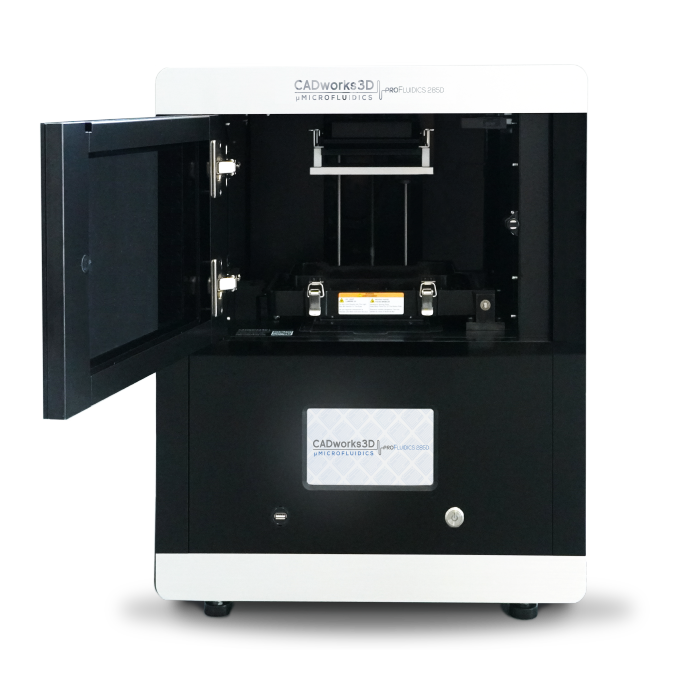APPLICATIONS
With the Cadworks3D μmicrofluidics 3D Printer, researchers are now able to 3D print devices for a number of microfluidic applications such as High-Throughput Devices, Lab-On-A chip, PDMS Master Molds, organ-on-a-chip, BioScaffoldings and many more. With our extensive knowledge in the industry and working with top research companies and universities, we are able to provide our users with the support they need to become industry leaders.
PDMS Mastermold
FASTER ITERATIONS
EASE OF USE
After printing, getting your master mold ready for use is as simple as cleaning the part in isopropyl alcohol and curing it under a UV light. PDMS can be cast directly onto the master mold and removed effortlessly without the use of a release agent.
DEVICE DURABILITY
Printed molds are able to withstand the temperatures of a conventional lab oven when curing PDMS, without the loss of printed features or deterioration of the master. The device can be used multiple times without the quality loss of PDMS.
UNMATCHED TRANSPARENCY
Create optically clear and non-toxic PDMS that can be fixed onto a glass slide using oxygen plasma – a clean room is not required throughout the process.
FASTER ITERATIONS
The master mold for PDMS resin has been specially formulated for the specific needs of researchers who cast PDMS devices. Print, cast, evaluate and iterate in the matter of hours instead of weeks. Features can be as fine as 50um (XY).
EASE OF USE
After printing, getting your master mold ready for use is as simple as cleaning the part in isopropyl alcohol and curing it under a UV light. PDMS can be cast directly onto the master mold and removed effortlessly without the use of a release agent.
DEVICE DURABILITY
Printed molds are able to withstand the temperatures of a conventional lab oven when curing PDMS, without the loss of printed features or deterioration of the master. The device can be used multiple times without the quality loss of PDMS.
UNMATCHED TRANSPARENCY
Create optically clear and non-toxic PDMS that can be fixed onto a glass slide using oxygen plasma – a clean room is not required throughout the process.
Lab-on-a chip
FASTER ITERATIONS
Our Clear Microfluidic Resin is specially formulated to help accelerate researchers’ design-to-test cycle. As opposed to weeks, you can create several iterations of your device with a wide range of layouts and features, evaluate these designs and validate their functionality, all in a matter of hours.
EASE OF USE
After printing, getting your device ready for use is as simple as cleaning the part in isopropyl alcohol and curing it under a UV light.
DEVICE DURABILITY
Print clear devices with smooth surface finishes and encapsulated channels as fine as 80um (XY). The low viscosity of the resin allows for the easy drainage of channels during printing, preventing them from clogging by the curing of trapped resin.
UNMATCHED TRANSPARENCY
The optical transparency of devices is prominent right out the printer and does not require any polishing or post-printing processes. The inert properties of the clear resin under fluorescent lights makes for easy evaluations at a microscopic level.
FASTER ITERATIONS
Our Clear Microfluidic Resin is specially formulated to help accelerate researchers’ design-to-test cycle. As opposed to weeks, you can create several iterations of your device with a wide range of layouts and features, evaluate these designs and validate their functionality, all in a matter of hours.
EASE OF USE
After printing, getting your device ready for use is as simple as cleaning the part in isopropyl alcohol and curing it under a UV light.
EXCEPTIONAL PRINT QUALITY
Print clear devices with smooth surface finishes and encapsulated channels as fine as 80um (XY). The low viscosity of the resin allows for the easy drainage of channels during printing, preventing them from clogging by the curing of trapped resin.
UNMATCHED TRANSPARENCY
The optical transparency of devices is prominent right out the printer and does not require any polishing or post-printing processes. The inert properties of the clear resin under fluorescent lights makes for easy evaluations at a microscopic level.
HIGH-THROUGHPUT DEVICES
Watch how 3D printing has changed the workflow of PhD candidate David Philpott at the Kelley lab, University of Toronto.
BIOSENORS HOUSING
Watch how 3D printing has changed the workflow of PhD candidate Surath Gomis at the Kelley Lab, University of Toronto.








